Last Updated: 15th October 2025
New York has long been the ultimate American destination for those leaving the United Kingdom. Ambitious, demanding, and alive at all hours. It remains the single most popular U.S. city for British movers, accounting for around 13% of our enquiries for international removals from the UK to the USA in a recent analysis, and topping our list of the best places to live in the US. No other city attracts quite the same gravitational pull.
This guide is not about visas or logistics (see our Moving to New York guide for that). It is about living in New York as a Brit once the practicalities of moving are done. From finding a pint that tastes like home to figuring out the city’s rhythm. In this guide, we don’t just describe New York, we interpret it for British expats, translating local habits, hidden costs, and cultural contrasts into practical guidance you can actually use.
For all its challenges (high rents, crowded streets, and a pace that makes London feel leisurely) New York rewards those who adapt quickly. It offers career momentum, cultural immersion, and the peculiar satisfaction of calling one of the world’s loudest cities home.
If you’re preparing to swap roundabouts for grid systems and terraced streets for skyline views, this guide will show you what life in New York truly looks like for a Brit moving to the Big Apple.
Table of Contents
Getting Oriented: Your First Weeks in the City
Your first few weeks in New York will be a blur. A mix of excitement, jet lag, and mild financial shock. The pace is relentless, but once you tune into it, you start to see how the city works. Here’s what helps most Brits settle in faster.
Adjusting to the Rhythm
New York runs 24 hours a day. The streets stay busy, deliveries never stop, and even late-night errands are normal. That constant movement can feel energising or overwhelming, depending on the day. Give yourself time to adjust. The noise, the energy, and the bluntness are part of the city’s DNA.
Social life also feels different. Striking up conversations with strangers is normal, and small talk moves quickly. Don’t mistake enthusiasm for superficiality. New Yorkers are direct but genuine and often expect the same.
Everyday Practicalities
Payments: Cash is rare. You’ll pay for almost everything with a debit or credit card, and contactless via Apple Pay or Google Pay works almost everywhere. Chip-and-pin is more uncommon than back in the UK.
Tipping: Expect to add 18-22% at restaurants, a dollar or two per drink at bars, and a few dollars for deliveries or taxis. It’s awkward at first, but tipping is part of the service economy, not optional.
Deliveries: Everything can be delivered. Groceries, meals, laundry and even prescriptions. Apps like Seamless, FreshDirect, and Instacart dominate, though delivery fees add up fast.
ID: Always carry a valid photo ID. Bars and even some stores check everyone, regardless of age. A UK driving licence often works, but a state-issued ID or passport is safer for night-time venues.
Your First Month’s Expenses
Even for those well prepared, the first month in New York can be financially intense. High rents, deposits, and everyday setup costs quickly add up.
For a single newcomer renting privately, the first month’s total outlay typically falls between US$9,500 and US$11,500, largely due to rent, deposit, and furnishing costs. Couples sharing a one-bedroom apartment can expect around US$11,000–13,500 combined.
| Category | Typical Monthly Cost (US$) | Notes |
|---|---|---|
| Rent (1 month) | US$4,200–5,600 average | Varies by borough and apartment size |
| Security deposit | US$4,200–5,600 | Usually equal to one month’s rent |
| Broker’s fee (if applicable) | US$0–5,000 | Some landlords still require this |
| Utilities and internet | US$300–400 | Electricity, heating, Wi-Fi |
| Groceries | US$300–600 | Typical supermarket spend for one person |
| Dining out and tipping | US$300–600 | Depends on frequency of eating out |
| Transport | US$132–250 | MetroCard and occasional rideshares |
| Initial household items | US$300–500 | Bedding, kitchenware, cleaning supplies |
| Furniture/furnishings | US$1,000–2,000 | One-off cost for unfurnished rentals |
| Healthcare and insurance | US$150–250 | Early medical or insurance payments |
| Miscellaneous (entertainment, gym, etc.) | US$200–400 | Gym, streaming, prescriptions, social activities |
| Estimated total first-month cost | US$9,500–13,500 | Includes rent, deposits, furnishings, and setup costs |
Navigating Daily Life: What Feels Different for Britons
Once the initial chaos settles, you’ll start noticing the details. The small cultural and practical differences that separate living in New York from living in London or Manchester. Some are subtle. Others are impossible to ignore. Here’s how daily life stacks up as a Brit in New York City.
Transport
The MTA subway is the backbone of the city, and it runs 24/7 (though “runs” doesn’t necessarily mean “runs on time.”) Think of it as London’s Tube, but louder, older, and unpredictable. The trains can be packed at odd hours, platforms are often hot in summer, and delays are routine. Still, even by American standards, it’s exceptional value. A flat fare gets you anywhere in the five boroughs, making New York one of the few places in the US where you can live comfortably without a car.
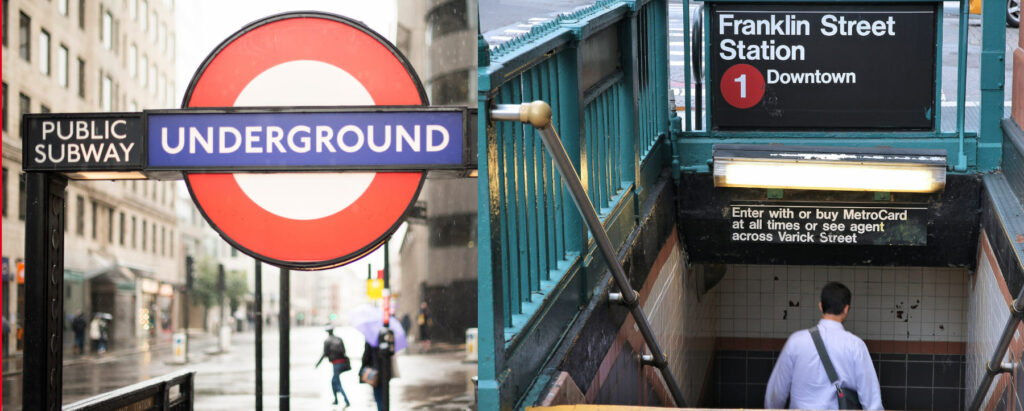
Late-night travel is usually safe in busy areas, but avoid empty carriages and keep valuables out of sight. If you’re thinking about getting it car, it usually only makes sense if you live outside Manhattan or have regular trips upstate. Parking in central areas is costly and scarce.
Credit and Direct Debits
Forget direct debit. It doesn’t exist in the same way as it does back in the UK. Instead, you’ll use autopay through each provider’s online system. Set it up early for rent, utilities, and your phone bill to avoid late fees.
Credit building is a must in the US. Without a US credit history, even phone contracts and apartment leases can be tricky. Start with a secured credit card or ask your bank for an entry-level option, then pay it off monthly to build your score.
Taxes are another adjustment. Most paychecks have federal, state, and city taxes deducted automatically, often around 25–35% total. Keep that in mind when budgeting: your “take-home” may be lower than expected.
Healthcare
This is one of the biggest cultural shocks for Brits. You’ll register with a Primary Care Provider (PCP) instead of a GP, and they act as your first point of contact for most health issues. Referrals are needed for specialists.
Insurance plans vary widely, but here’s what to expect in practice:
- GP visit: $100–$200 before insurance
- Prescription: $10–$60 depending on coverage
- Emergency room: $1,000+ (seriously, use urgent care clinics when possible)
Always carry your insurance card, and confirm a clinic or hospital is “in-network” before treatment. It’s bureaucratic, but once you understand the system, it becomes manageable.
Groceries and Dining
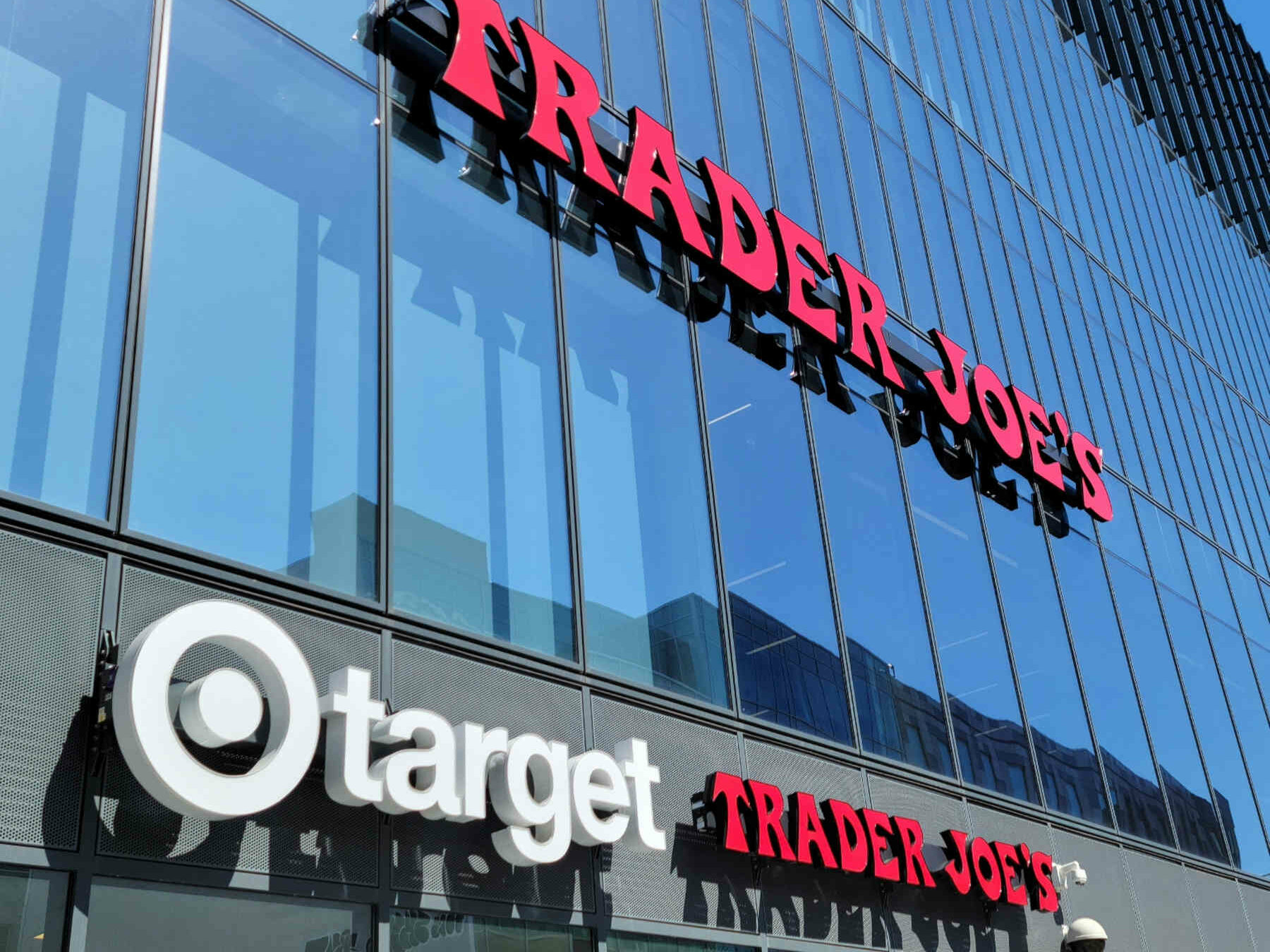
Some things are cheaper than the UK, such as tech, local produce and eating out for lunch. Others are not. Eggs, dairy products, alcohol, and most British imports will cost more.
Here’s what helps keep your weekly food budget realistic:
- Supermarkets: Trader Joe’s (value), Whole Foods (quality, pricey), Key Food and Stop & Shop (standard), Morton Williams (convenience)
- Markets: Union Square Greenmarket and local weekend farmers’ markets for fresh produce
- Delivery apps: Instacart, FreshDirect, Amazon Fresh. Useful but with high fees
- UK staples: Myers of Keswick, Tea & Sympathy, and British Corner Shop (ships from the UK)
A typical weekly grocery bill for one person runs $100–$150, depending on habits.
Living Like a Brit in New York
Once the basics are sorted, the question becomes: how do you actually live here? New York is full of British touches if you know where to look, and it’s also one of the easiest cities in the world to make new friends fast. Here’s how most Britons find their footing.
British Comforts
Sometimes you just need a proper cuppa or a decent pint. Luckily, New York delivers on both.
For a full English breakfast, a few expat favourites include Tea & Sympathy and Jones Wood Foundry. If you’re craving roast dinners (or a pint), The Churchill Tavern and The Shakespeare (among others) are solid bets for traditional British pub food and drinks.
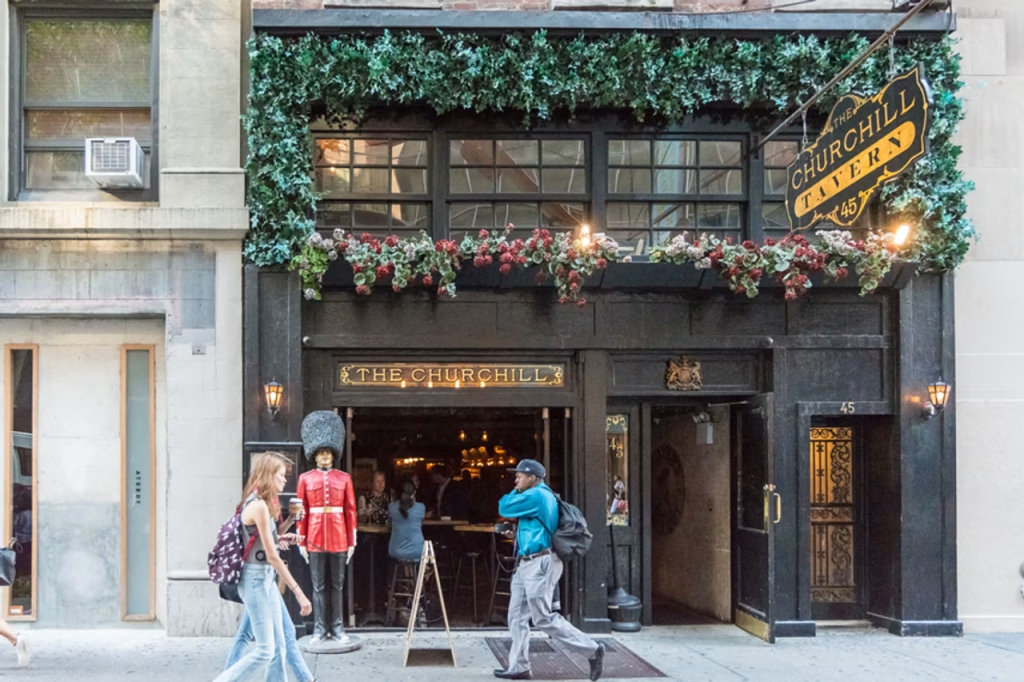
Shops and online stores that carry UK staples include Myers of Keswick (sausages, crisps, beans), Carry On Tea & Sympathy, and British Corner Shop for online delivery straight from the UK.
Keeping up with British TV and sport
Most British streaming platforms work fine with a VPN (handy if you can’t live without Match of the Day or Bake Off.) BBC Sounds, ITVX, and Channel 4 all stream through VPNs, while BritBox offers plenty of home comforts without a VPN.
For football and rugby, many pubs open early for Premier League and Six Nations matches, especially in Midtown and the East Village. Bars like Football Factory at Legends, Smithfield Hall, The Red Lion and The Long Acre often livestream these events.
Social Life and Integration
Socialising here feels more spontaneous than in the UK. New Yorkers are open to meeting new people, and plans happen fast.
Expat and networking groups make things easier. Try British Expats in New York on Facebook, The New York British Social Group on meetup (and other similar groups), Internations New York and events hosted by British-American Business.
Culturally, expect more directness and enthusiasm in both social and work settings. Colleagues might overshare or give feedback bluntly. It’s not rudeness, just normal New York efficiency. You’ll adapt faster if you lean into it rather than compare it to home.
Leisure and Escapes
When you need a breather, you don’t have to go far. Central Park, Prospect Park, and the Hudson River trails are the city’s equivalent of Hyde Park or Hampstead Heath. Green space threaded into the chaos. They’re where New Yorkers run, relax, and reset.

Beyond the city, weekend escapes are easy. Think of the Hudson Valley as New York’s answer to the Cotswolds, with rolling countryside, farm shops, wineries, and quiet towns that fill with city dwellers each weekend. Beacon has the artsy, small-town charm of somewhere like Totnes or Rye, while the Hamptons offer a coastal break that feels somewhere between Devon and Cornwall, only with more celebrity sightings (and higher prices.)
Seasonal traditions survive in New York, too. British expat communities hosts pub quizzes, Burns Night suppers, and Christmas parties across the city. You’ll even find pancake races and Coronation Day gatherings. Following British holidays gives a nice anchor through the year, especially when Thanksgiving and July 4th still feel foreign.
The best part of these comforts isn’t nostalgia, it’s a sense of normality. When you can drink a decent cup of tea, watch your club play live, and find “proper bacon” for a weekend fry-up, the city starts to feel less like a foreign adventure and more like a home.
Family, Schools, and Seasonal Life
New York isn’t just for singles or professionals. Plenty of British families make it work here too. The setup takes a bit of learning, especially around schooling and seasons.
Schools and Education
The US school system looks familiar on the surface but works very differently in practice. Instead of “state” and “private,” you’ll hear public, charter, and private schools.
- Public schools are free and funded by local taxes. The catch: your address determines your child’s school. That’s why families often choose apartments based on school districts, especially in areas like the Upper West Side or Brooklyn’s Park Slope.
- Charter schools are free but operate independently, with their own admission processes and teaching styles.
- Private schools charge anywhere from $25,000 to $60,000 a year, comparable to high-end UK independents.
For younger children, daycare and preschool costs can be a shock. Full-time childcare often runs between $2,000 and $3,000 a month, depending on the neighbourhood. The school year runs from September to late June, similar to the UK, but with a much longer summer break.
Family Life and Routine
Family life tends to centre around the local community in parks, playgrounds, and after-school programmes.
Brits often notice that school involvement is more hands-on here. Expect to volunteer, attend fundraisers, and get regular communication from teachers.
Seasonal Rhythm
New York has real seasons, and they shape daily life more than you might expect. Winters are cold (properly cold) with snow, ice, and sub-zero mornings that make London drizzle seem mild. Layer up and invest in proper boots; it’s a non-negotiable.
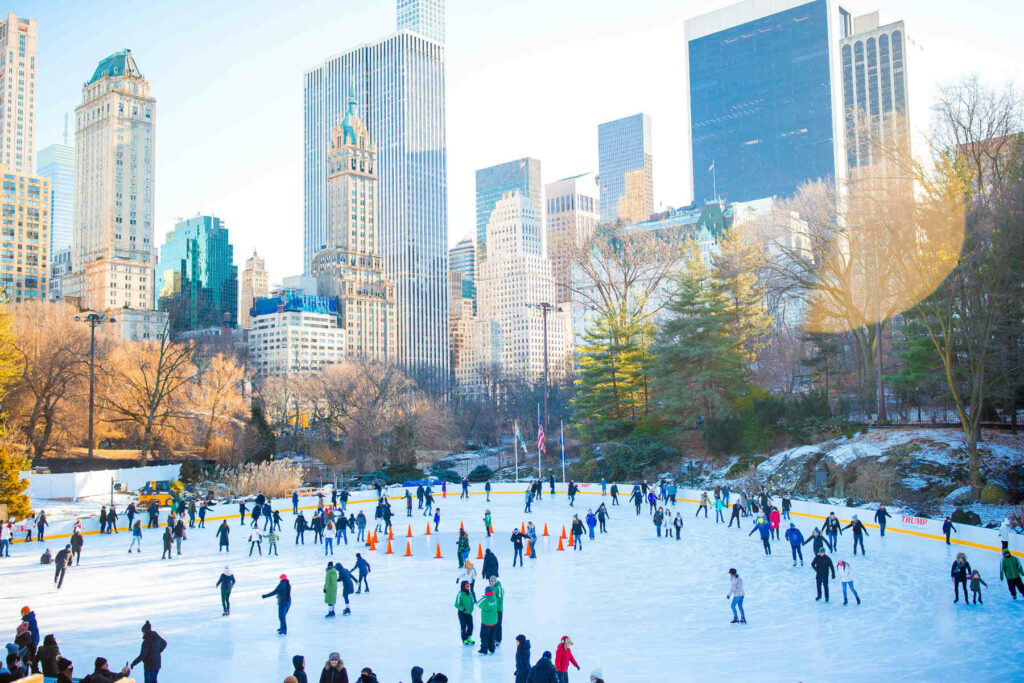
Spring feels short but sweet, summer is humid and vibrant, and autumn is the showstopper. Crisp air, Golden leaves, and weekend trips upstate to see the colours. Locals lean into the seasons, from rooftop bars and baseball in summer to ice rinks and Christmas markets in winter.
For families, New York demands more planning and patience than most UK cities, but it rewards the effort with opportunity. Great schools, cultural diversity, and world-class activities are all within reach as long as you embrace the city’s tempo.
Perspective and Practical Insight
Every expat experience follows the same arc: excitement, confusion, adaptation. New York just speeds that process up. Ask anyone who’s lived here more than a year and you’ll hear the same themes of what’s hardest at first, and what eventually makes it worth it.
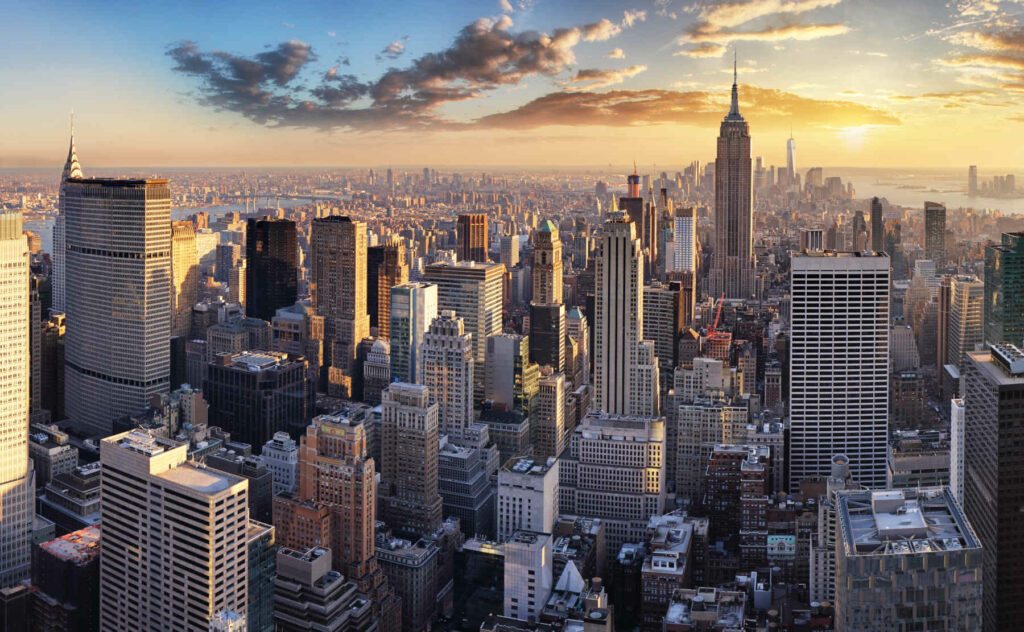
What Brits Find Hardest
The cost. Rent, food, healthcare. Everything seems to come with a surcharge. Even seasoned Londoners are surprised by how quickly small expenses pile up. The trick is to accept it early and budget realistically. Cheap doesn’t usually exist here, but value does.
The pace. The city moves fast, and people expect the same from you. There’s little patience for dithering, whether you’re ordering coffee or crossing the street. Once you stop fighting the speed and start flowing with it, life gets easier.
The bureaucracy. Opening a bank account, setting up insurance, or getting a driver’s licence all involve more paperwork than you’d think. Systems vary by state, and “next week” rarely means next week. Patience is key.
What Brits Come to Love
Diversity. No single “type” of New Yorker exists. You’ll meet people from everywhere, and that mix makes the city feel oddly inclusive, even amidst the chaos.
Culture. From Broadway to street food, there’s something happening every night of the week. Art, sport, live music. It’s all accessible, and often world-class.
Opportunity. The cliché is true: New York rewards effort. If you show up, put in the work, and make connections, the city responds. It’s demanding, but it can give back as much (if not more) than it takes.
Data Insight: Why New York Dominates UK Moves
Our internal data shows 13% of all UK-to-US enquiries are for New York, more than Los Angeles, Houston, and San Francisco combined. The draw isn’t just jobs; it’s lifestyle. Britons relocating here tend to be younger professionals, creatives, and finance workers, many of whom already know the city through travel or work, but people from all walks of life can find a place in New York.
Thriving in the City That Never Sleeps
For Britons, New York can feel like a familiar stranger. The same urban rhythm, but louder, faster, and more expensive. You’ll still find your local, a favourite coffee spot, and your version of a Sunday roast; it just takes a bit of searching.
You’ll still miss British politeness, a reliable train service, or the quiet of a countryside weekend. But you’ll gain something else, a sense that you can handle almost anything. Living here sharpens you. It teaches you to adapt, to speak up, and to make a home out of chaos.
The Britons who thrive in New York don’t try to recreate the UK. They build a bridge between both worlds, keeping the comfort of familiarity while embracing the energy of something bigger. That balance is what turns New York from a challenge into a chapter worth staying for.

